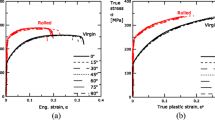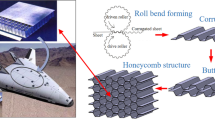Abstract
The aim of this work was the analysis of the relationships between material properties and forming limits of a sheet, caused by the strain localization in the groove. In particular, we aim at the replacement of a nonmeasurable inhomogeneity coefficient of the material, the value of which has to be taken a priori, by measurable coefficients. In the proposed model, it is assumed that the material heterogeneity is a result of surface roughness and presence of internal defects (voids). The value of inhomogeneity coefficients changes with increasing strain. The experiments were carried out for M85 brass sheets, annealed to produce different microstructures. The measured values of some material parameters: strain-hardening constants n and C, normal anisotropy factors, inhomogeneity coefficients (surface roughness and volume fraction of voids) as well as forming limit curve demonstrated their dependence on the grain size. As a result of the experimental work, original equations were proposed, describing the relationship between inhomogeneity coefficients and effective strain and grain size. These equations were used in the theoretical calculation of the forming limit diagram. The theoretical calculations of the strain limits of the tested sheets were based on the associated flow rules, assuming strain-hardening and strain-softening process (Shima–Oyane equation and equations based on the Gurson theory). The analysis of the influence of different material parameters on the forming limit diagram has shown that in the case of the material tested, the value of limit strains depends decisively on the values of the inhomogeneity coefficients and grain size. The postulates showing proportional relationship between the value of a strain-hardening exponent and limit strains were not confirmed.
Similar content being viewed by others
References
Abbassi F., Mistou S., Zghal A.: Failure analysis based on microvoid growth for sheet metal during uniaxial and biaxial tensile test. Mater. Des. 49, 638–646 (2013)
Alexandrov, S., Manabe, K.-I., Furushima, T.: A new empirical relation for free surface roughening. J. Manuf. Sci. Eng. (2011). doi:10.1115/1.4003477
Carroll J.D., Brewer L.N., Battaile C.C., Boyce B.L., Emery J.M.: The effect of grain size on local deformation near a void-like stress concentration. Int. J. Plast. 39, 46–60 (2012)
Chan K.S., Koss D.A., Ghosh A.K.: Localized necking of sheet at negative minor strains. Metall. Trans. 15A, 323–329 (1984)
Chen Z., Worswick M.J.: Investigation of void nucleation in Al–Mg sheet. Mater. Sci. Eng. A 483–484, 99–101 (2008)
Chu C.C., Needleman A.: Void nucleation effects in biaxially stretched sheets. Trans. ASME J. Eng. Mater. Technol. 102, 249–256 (1980)
Fukuda M., Yamaguchi K., Takakura N., Sakano Y.: Roughening phenomenon on free surface of products in sheet metal forming. J. Jpn. Soc. Technol. Plast. 15, 994–1002 (1974)
Furushima T., Tsunazaki H., Manabe K.-I., Alexandrov S.: Ductile fracture and free surface roughening behaviors of pure copper foils for micro/meso-scale forming. Int. J. Mach. Tools Manuf. 26, 34–48 (2014)
Ghazanfari A., Assempour A.: Calibration of forming limit diagrams using a modified Marciniak–Kuczynski model and an empirical law. Mater. Des. 34, 185–191 (2012)
Gurson A.L.: Continuum theory of ductile rupture by void nucleation and growth: part I—yield criteria and flow rules for porous ductile materials. Trans. ASME J. Eng. Mater. Technol. 99, 2–15 (1977)
Hill R.: On discontinuous plastic state, with special reference to localized necking in thin sheets. J. Mech. Phys. Solids 1, 19–30 (1952)
Jonas J.J., Baudelet B.: Effect of crack and cavity generation on tensile stability. Acta Metall. 25, 43–50 (1977)
Le Roy G., Embury J.D., Edward G., Ashby M.F.: A model of ductile fracture based on the nucleation and growth of voids. Acta Metall. 29, 1509–1522 (1981)
Marciniak Z., Kuczyński K.: Limit strains in the process of stretch forming of sheet metal. Int. J. Mech. Sci. 9, 609–620 (1967)
Marciniak Z., Kuczyński K., Pokora T.: Influence of the plastic properties of a material on the forming limit diagram for sheet metal in tension. Int. J. Mech. Sci. 15, 789–805 (1973)
Melander A.: A new model of the forming limit diagram applied to experiments on copper-base-alloys. Mater. Sci. Eng. 58, 63–88 (1983)
Needleman A., Triantafyllidis N.: Void growth and local necking in biaxially stretched sheets. Trans. ASME J. Eng. Mater. Technol. 100, 164–169 (1978)
Parmar A., Mellor P.B.: A new model for the prediction of instability and limit strains in thin sheet metal. Int. J. Mech. Sci. 19, 389–398 (1977)
Parmar A., Mellor P.B.: Growth of voids in biaxial stress fields. Int. J. Mech. Sci. 22, 133–150 (1980)
Ragab A.R.: Prediction of fracture limit curves in sheet metals using a void growth and coalescence model. J. Mater. Proc. Technol. 199, 206 (2008)
Rice J.R., Tracey D.M.: On the ductile enlargement of voids in triaxial stress field. J. Mech. Phys. Solids 17, 201–217 (1969)
Schmitt J.H., Jalinier J.M.: Damage in sheet metal forming—I. Physical behavior. Acta Metall. 30, 1789–1798 (1982)
Shima S., Oyane M.: Plasticity theory for porous metals. Int. J. Mech. Sci. 18, 285–291 (1976)
Spitzig W.A., Smelser R.E., Richmond O.: The evolution of damage and fracture in iron compacts with various initial porosities. Acta Metall. 36, 1201–1211 (1988)
Stören S., Rice J.R.: Localized necking in thin sheets. J. Mech. Phys. Solids 23, 421–441 (1975)
Tvergaard V.: Effect of yield surface curvature and void nucleation on plastic flow localization. J. Mech. Phys. Solids 35, 43–60 (1987)
Tvergaard V.: Discrete modeling of ductile crack growth by void growth to coalescence. Int. J. Fract. 148, 1–12 (2007)
Tvergaard V.: On cavitation instabilities with interacting voids. Eur. J. Mech. A Solids 32, 52–58 (2012)
Vial C.: Yield locus of 70–30 brass sheet metals. Int. J. Mech. Sci. 30, 137–143 (1988)
Welch P.I., Ratke L., Bunge H.-J.: Consideration of anisotropy parameters in polycrystalline metals. Z. Metallkunde Metallphysic 74, 233–237 (1983)
Wagoner R.H.: Plastic behavior of 70–30 brass sheet. Metall. Trans. 13A, 1491–1500 (1982)
Wilson D.V., Mirshams A.R., Roberts W.T.: An experimental study of the effect of sheet thickness and grain size on limit-strains in biaxial stretching. Int. J. Mech. Sci. 25, 859–870 (1983)
Yamaguchi K., Mellor P.B.: Thickness and grain size dependence of limit strains in sheet metal stretching. Int. J. Mech. Sci. 18, 85–90 (1976)
Author information
Authors and Affiliations
Corresponding author
Rights and permissions
About this article
Cite this article
Stachowicz, F. On the connection between microstructure and surface roughness of brass sheets and their formability. Acta Mech 227, 253–262 (2016). https://doi.org/10.1007/s00707-015-1416-1
Received:
Revised:
Published:
Issue Date:
DOI: https://doi.org/10.1007/s00707-015-1416-1




